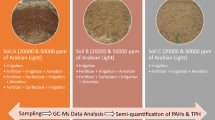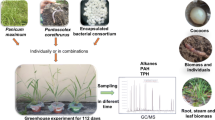Abstract
Contamination of soil and water with petroleum hydrocarbons and metals can pose a significant threat to the environment and human health. This study aimed to investigate the establishment and growth of tall fescue and agropyron in two petroleum-contaminated soils (soil S1 and soil S2) with previous landfarming treatments, and to assess the phytoremediation potential for heavy metal removal from these polluted soils. The results showed that the presence of petroleum hydrocarbons significantly (P < 0.05) reduced plant growth, but plant development was facilitated in soils with prior landfarming treatments. Urease activity in the rhizosphere of agropyron for soil S1 was about 47% higher than the unplanted control soil. The rhizosphere of agropyron and tall fescue eliminated more than 40% and 20% of total hydrocarbon amounts in soil S1, respectively, compared to the unplanted soil. Moreover, the plants grown in the landfarming treatment exhibited higher concentrations of metals (Fe, Zn, Mn, Cu, and Ni) than the control. Based on the findings, the combination of landfarming and phytoremediation techniques can provide an optimal solution for removing mixed pollutants, including petroleum hydrocarbons and metals, from the environment.





Similar content being viewed by others
Explore related subjects
Discover the latest articles and news from researchers in related subjects, suggested using machine learning.Data availability
The data that support the findings of this study are available from the corresponding author upon reasonable request (mfadaei@nri.ac.ir).
Notes
Analytical chemistry method for determining total nitrogen.
References
Akpokodje O, Uguru H (2019) Phytoremediation of petroleum products contaminated soil. Arch Curr Res Int 18:1–8. https://doi.org/10.9734/ACRI/2019/v18i130127
Akpokodje O, Juwah H, Uguru H (2022) Impacts of petroleum spills on geotechnical properties of soils: a review. Eng Innov Appl 1:3–8. https://doi.org/10.31248/JEIA2022.021
Baghaie AH, Daliri A (2020) The effect of organic chelates and gibberellic acid on petroleum hydrocarbons degradation in the soil co-contaminated with Ni and crude oil under canola cultivation [Original Article]. Environ Health Eng Manag J 7(1):15–22. https://doi.org/10.34172/ehem.2020.03
Bai L, Liu XL, Hu J, Li J, Wang ZL, Han G, Li SL, Liu CQ (2018) Heavy metal accumulation in common aquatic plants in rivers and lakes in the Taihu Basin. Int J Environ Res Public Health 15(12). https://doi.org/10.3390/ijerph15122857
Besalatpour AA, Khoshgoftarmanesh A, Hajabbasi M, Majid A (2008) Germination and growth of selected plants in a petroleum contaminated calcareous soil. Soil Sediment Contam 17:665–676. https://doi.org/10.1080/15320380802425113
Besalatpour AA, Hajabbasi M, Khoshgoftarmanesh A (2010) Reclamation of a petroleum-contaminated calcareous soil using phytostimulation. Soil Sediment Contam: An Int J 19:547–559. https://doi.org/10.1080/15320383.2010.499920
Besalatpour AA, Hajabbasi M, Khoshgoftarmanesh A, Dorostkar V (2011) Landfarming process effects on biochemical properties of petroleum-contaminated soils. Soil Sediment Contam 20:234–248. https://doi.org/10.1080/15320383.2011.546447
Bouafia A, Meneceur S, Chami S, Laouini SE, Daoudi H, Legmairi S, Mohammed Mohammed HA, Aoun N, Menaa F (2023) Removal of hydrocarbons and heavy metals from petroleum water by modern green nanotechnology methods. Sci Rep 13(1):5637. https://doi.org/10.1038/s41598-023-32938-1
Cavazzoli S, Selonen V, Rantalainen A-L, Sinkkonen A, Romantschuk M, Squartini A (2022) Natural additives contribute to hydrocarbon and heavy metal co-contaminated soil remediation. Environ Pollut 307:119569. https://doi.org/10.1016/j.envpol.2022.119569
Chaîneau CH, Morel J-L, Oudot J (1997) Phytotoxicity and plant uptake of fuel oil hydrocarbons. J Environ Qual 26:1478–1483. https://doi.org/10.2134/JEQ1997.00472425002600060005X
Correa Garcia S, Pande P, Seguin A, St-Arnaud M, Yergeau E (2018) Rhizoremediation of petroleum hydrocarbons: a model system for plant microbiome manipulation. Microb Biotechnol 11. https://doi.org/10.1111/1751-7915.13303
Egamberdieva D, Renella G, Wirth S, Islam R (2011) Enzyme activities in the rhizosphere of plants. In (Vol. 22), , pp 149–166. https://doi.org/10.1007/978-3-642-14225-3_8
Gouveia R (2020) Global population growth and industrial impact on the environment. In, pp 33–75. https://doi.org/10.1007/978-3-030-23165-1_3
Günther T, Dornberger U, Fritsche W (1996) Effects of ryegrass on biodegradation of hydrocarbons in soil. Chemosphere 33(2):203–215. https://doi.org/10.1016/0045-6535(96)00164-6
Kassem Alef PN (1995) Methods in applied soil microbiology and biochemistry, 1st edn. Academic Press, London. https://doi.org/10.1016/B978-0-12-513840-6.X5014-9
Keyghobadi S, Mahmoudi E, Hoodaji M, Jalalizand A, شناسی, م (2022) The effect of heavy metals and petroleum hydrocarbons on the Collembolan fauna in soil of some industrial regions of Isfahan. J Environ Stud 48. https://doi.org/10.22059/JES.2022.328017.1008209
Koshlaf E, Ball AS (2017) Soil bioremediation approaches for petroleum hydrocarbon polluted environments. AIMS Microbiol 3(1):25–49. https://doi.org/10.3934/microbiol.2017.1.25
Kulakow P, Schwab A, Banks M (2000) Screening plant species for growth on weathered, petroleum hydrocarbon-contaminated sediments. Int J Phytoremediat 2:297–317. https://doi.org/10.1080/15226510008500040
Labianca Claudia SDG, Picardi F, Todaro F, Notarnicola M (2020) Remediation of a petroleum hydrocarbon-contaminated site by soil vapor extraction: a full-scale case study. Appl Sci 10(12). https://doi.org/10.3390/app10124261
Li C, Ma B, Zhang T (2002) Soil bulk density effects on soil microbial populations and enzyme activities during the growth of maize ( Zea mays L.) planted in large pots under field exposure. Can J Soil Sci 82:147–154. https://doi.org/10.4141/S01-026
Liu R, Jadeja R, Zhou Q, Liu Z (2012) Treatment and remediation of petroleum-contaminated soils using selective ornamental plants. Environ Eng Sci 29:494–501. https://doi.org/10.1089/ees.2010.0490
Majumder A, Ray S, Jha S (2017) Hairy roots and phytoremediation. In, pp 1–24. https://doi.org/10.1007/978-3-319-54600-1_22
Margesin R, Walder G, Schinner F (2000) The impact of hydrocarbon remediation (diesel oil and polycyclic aromatic hydrocarbons) on enzyme activities and microbial properties of soil. Acta Biotechnol 20:313–333. https://doi.org/10.1002/abio.370200312
Merkl N, Schultze-Kraft R, Infante C (2004) Phytoremediation of petroleum-contaminated soils in the tropics - pre-selection of plant species from eastern Venezuela. J Appl Bot Food Qual 78:185–192
Mitra S, Chakraborty AJ, Tareq AM, Emran TB, Nainu F, Khusro A, Idris AM, Khandaker MU, Osman H, Alhumaydhi FA, Simal-Gandara J (2022) Impact of heavy metals on the environment and human health: novel therapeutic insights to counter the toxicity. J King Saud Univ - Sci 34(3):101865. https://doi.org/10.1016/j.jksus.2022.101865
Munter R, Halverson T, Anderson R (1984) Quality assurance for plant tissue analysis by ICP-AES. Commun Soil Sci Plant Anal 15:1285–1322. https://doi.org/10.1080/00103628409367559
Münzel T, Hahad O, Daiber A, Landrigan PJ (2023) Soil and water pollution and human health: what should cardiologists worry about? Cardiovasc Res 119(2):440–449. https://doi.org/10.1093/cvr/cvac082
Nedunuri K, Govindaraju R, Banks M, Schwab A, Chen Z (2000) Evaluation of phytoremediation for field-scale degradation of total petroleum hydrocarbons. J Environ Eng-asce 126. https://doi.org/10.1061/(ASCE)0733-9372(2000)126:6(483)
Ngwenya N, Mahlambi P (2023) Methods optimization and application: solid phase extraction, ultrasonic extraction and Soxhlet extraction for the determination of antiretroviral drugs in river water, wastewater, sludge, soil and sediment. J Pharm Biomed Anal 230:115358. https://doi.org/10.1016/j.jpba.2023.115358
Ossai IC, Ahmed A, Hassan A, Hamid FS (2020) Remediation of soil and water contaminated with petroleum hydrocarbon: a review. Environ Technol Innov 17:100526. https://doi.org/10.1016/j.eti.2019.100526
Parsad R (2010) SAS for Statistical Procedures
Seneviratne M, Seneviratne G, Madawala H, Vithanage M (2017) Role of rhizospheric microbes in heavy metal uptake by plants. In, pp 147–163. https://doi.org/10.1007/978-3-319-49727-3_8
Sessitsch A, Kuffner M, Kidd P, Vangronsveld J, Wenzel WW, Fallmann K, Puschenreiter M (2013) The role of plant-associated bacteria in the mobilization and phytoextraction of trace elements in contaminated soils. Soil Biol Biochem 60(100):182–194. https://doi.org/10.1016/j.soilbio.2013.01.012
Siddiqua A, Hahladakis JN, Al-Attiya W (2022) An overview of the environmental pollution and health effects associated with waste landfilling and open dumping. Environ Sci Pollut Res Int 29(39):58514–58536. https://doi.org/10.1007/s11356-022-21578-z
Tehrani MRF, Shamsai S, Vossughi M (2015) In-situ Pb remediation using nano iron particles. J Environ Health Sci Eng 13(1). https://doi.org/10.1186/s40201-015-0157-3
Truskewycz A, Gundry TD, Khudur LS, Kolobaric A, Taha M, Aburto-Medina A, Ball AS, Shahsavari E (2019) Petroleum hydrocarbon contamination in terrestrial ecosystems-fate and microbial responses. Molecules 24(18). https://doi.org/10.3390/molecules24183400
Weaver RW, Angle S, Bottomley P, Bezdicek DF, Smith S, Tabatabai A, Wollum AG (1994) Methods of Soil Analysis: Part 2, Microbial and Biochemical Properties. Soil Science Society of America.https://doi.org/10.2136/sssabookser5.2
Wiltse CC, Rooney WL, Chen Z, Schwab AP, Banks MK (1998) Greenhouse evaluation of agronomic and crud oil phytoremediation potential among alfalfa genotypes. Environ Qual 27(1):4
Xu SY, Chen YX, Wu WX, Wang KX, Lin Q, Liang XQ (2006) Enhanced dissipation of phenanthrene and pyrene in spiked soils by combined plants cultivation. Sci Total Environ 363(1–3):206–215. https://doi.org/10.1016/j.scitotenv.2005.05.030
Author information
Authors and Affiliations
Contributions
Both authors (Mohamad Reza Fadaei Tehrani and Ali Asghar Besalatpour) contributed to the study conception and design of the research as well as field and laboratory analysis. Both authors were also involved in writing the manuscript and have read, commented, and approved the final manuscript.
Corresponding author
Ethics declarations
Ethical approval
Both authors (Mohamad Reza Fadaei Tehrani and Ali Asghar Besalatpour) have carefully reviewed, comprehended, and adhered to the “Ethical Responsibilities of Authors” statement outlined in the Instructions for Authors. They are aware that, with few exceptions, no modifications can be made to the authorship once the paper has been submitted.
Consent to participate
Not applicable.
Consent for publication
Not applicable.
Competing interests
The authors declare no competing interests.
Additional information
Responsible Editor: Elena Maestri
It is necessary to toast that “we have not submitted our manuscript to a preprint server before submitting it to Environmental Science and Pollution Research.” It is necessary to mention all or even a part of this article has not been published before in any scientific publication or reference and is not under review by any other journal. Also, all the authors have reached a consensus to submit the draft of the article to journal of Environmental Science and Pollution Research. Also, the authors acknowledge that they have fully assigned the right to publish this article to journal of Environmental Science and Pollution Research.
Publisher's Note
Springer Nature remains neutral with regard to jurisdictional claims in published maps and institutional affiliations.
Rights and permissions
Springer Nature or its licensor (e.g. a society or other partner) holds exclusive rights to this article under a publishing agreement with the author(s) or other rightsholder(s); author self-archiving of the accepted manuscript version of this article is solely governed by the terms of such publishing agreement and applicable law.
About this article
Cite this article
Tehrani, M.R.F., Besalatpour, A.A. A combined landfarming-phytoremediation method to enhance remediation of mixed persistent contaminants. Environ Sci Pollut Res 31, 37163–37174 (2024). https://doi.org/10.1007/s11356-024-33606-1
Received:
Accepted:
Published:
Issue Date:
DOI: https://doi.org/10.1007/s11356-024-33606-1




